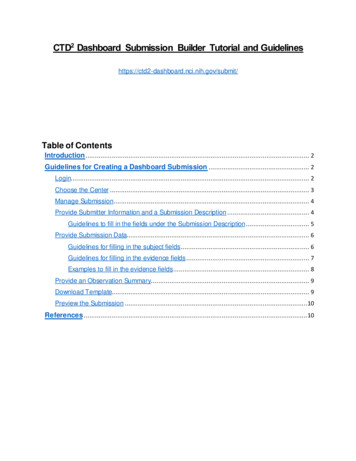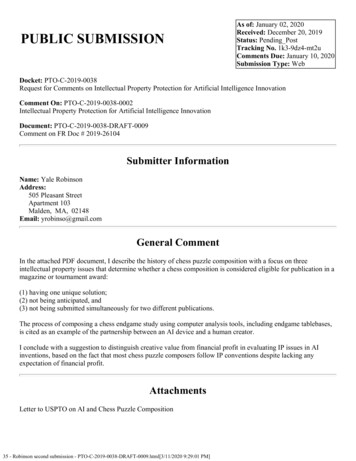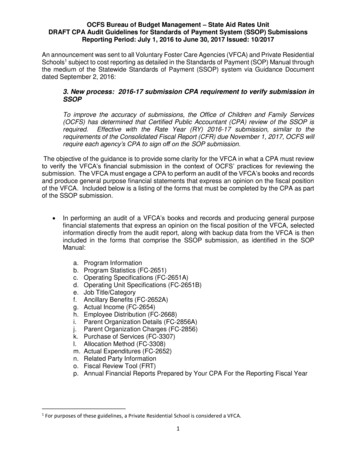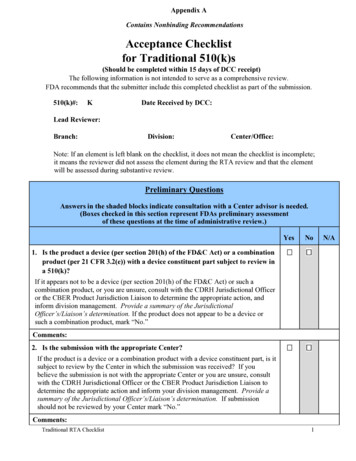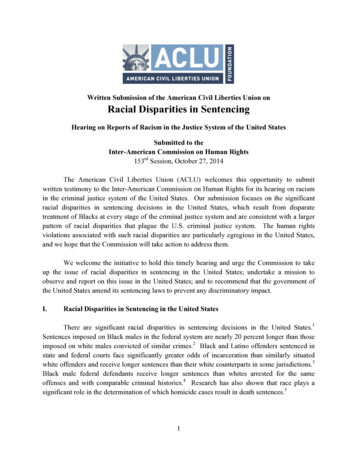
Transcription
Written Submission of the American Civil Liberties Union onRacial Disparities in SentencingHearing on Reports of Racism in the Justice System of the United StatesSubmitted to theInter-American Commission on Human Rights153rd Session, October 27, 2014The American Civil Liberties Union (ACLU) welcomes this opportunity to submitwritten testimony to the Inter-American Commission on Human Rights for its hearing on racismin the criminal justice system of the United States. Our submission focuses on the significantracial disparities in sentencing decisions in the United States, which result from disparatetreatment of Blacks at every stage of the criminal justice system and are consistent with a largerpattern of racial disparities that plague the U.S. criminal justice system. The human rightsviolations associated with such racial disparities are particularly egregious in the United States,and we hope that the Commission will take action to address them.We welcome the initiative to hold this timely hearing and urge the Commission to takeup the issue of racial disparities in sentencing in the United States; undertake a mission toobserve and report on this issue in the United States; and to recommend that the government ofthe United States amend its sentencing laws to prevent any discriminatory impact.I.Racial Disparities in Sentencing in the United StatesThere are significant racial disparities in sentencing decisions in the United States.1Sentences imposed on Black males in the federal system are nearly 20 percent longer than thoseimposed on white males convicted of similar crimes.2 Black and Latino offenders sentenced instate and federal courts face significantly greater odds of incarceration than similarly situatedwhite offenders and receive longer sentences than their white counterparts in some jurisdictions.3Black male federal defendants receive longer sentences than whites arrested for the sameoffenses and with comparable criminal histories.4 Research has also shown that race plays asignificant role in the determination of which homicide cases result in death sentences.51
The racial disparities increase with the severity of the sentence imposed. The level ofdisproportionate representation of Blacks among prisoners who are serving life sentenceswithout the possibility of parole (LWOP) is higher than that among parole-eligible prisonersserving life sentences. The disparity is even higher for juvenile offenders sentenced to LWOP,and higher still among prisoners sentenced to LWOP for nonviolent offenses. Although Blacksconstitute only about 13 percent of the U.S. population, as of 2009, Blacks constitute 28.3percent of all lifers, 56.4 percent of those serving LWOP, and 56.1 percent of those who receivedLWOP for offenses committed as a juvenile.6 As of 2012, the ACLU’s research shows that 65.4percent of prisoners serving LWOP for nonviolent offenses are Black.7The racial disparities are even worse in some states. In 13 states and the federal system,the percentage of Blacks serving life sentences is over 60 percent.8 In Georgia and Louisiana,the proportion of Blacks serving LWOP sentences is as high as 73.9 and 73.3 percent,respectively.9 In the federal system, 71.3 percent of the 1,230 LWOP prisoners are Black.10These racial disparities result from disparate treatment of Blacks at every stage of thecriminal justice system, including stops and searches, arrests, prosecutions and plea negotiations,trials, and sentencing.11 Race matters at all phases and aspects of the criminal process, includingthe quality of representation, the charging phase, and the availability of plea agreements, each ofwhich impact whether juvenile and adult defendants face a potential LWOP sentence. Inaddition, racial disparities in sentencing can result from theoretically “race neutral” sentencingpolicies that have significant disparate racial effects, particularly in the cases of habitual offenderlaws and many drug policies, including mandatory minimums, school zone drug enhancements,and federal policies adopted by Congress in 1986 and 1996 that at the time established a 100-toone sentencing disparity between crack and powder cocaine offenses.12Racial disparities in sentencing also result in part from prosecutors’ decisions at theinitial charging stage, suggesting that racial bias affects the exercise of prosecutorial discretionwith respect to certain crimes. One study found that Black defendants face significantly moresevere charges than whites, even after controlling for characteristics of the offense, criminalhistory, defense counsel type, age and education of the offender, and crime rates and economiccharacteristics of the jurisdiction.13Available data also suggests that there are racial disparities in prosecutors’ exercise ofdiscretion in seeking sentencing enhancements under three-strikes and other habitual offenderlaws.14 For instance, a 1995 legal challenge revealed the racially biased role of prosecutorialdiscretion in the application of Georgia’s two-strikes law. Georgia prosecutors have discretion todecide whether to charge offenders under the state’s two-strikes sentencing scheme, whichimposes life imprisonment for a second drug offense. They invoked the law against only 1percent of white defendants facing a second drug conviction, compared to 16 percent of Blackdefendants.15 As a result, 98.4 percent of prisoners serving life sentences under the law were2
Black.16 In California, studies similarly show that Blacks are sentenced under the state’s threestrikes law at far higher rates than their white counterparts.17Scholars have also noted that federal § 851 sentencing enhancements, which at aminimum double a federal drug defendant’s mandatory minimum sentence and may raise themaximum sentence from 40 years to life without parole if the defendant has two prior qualifyingdrug convictions in state or federal courts, are applied by federal prosecutors in an arbitrary andracially discriminatory manner and exacerbate racial disparities in the criminal justice system.18While the U.S. Department of Justice and U.S. Sentencing Commission do not develop orpublicize data on racial disparities in prosecutors’ application of this federal drug sentencingenhancement, the U.S. Sentencing Commission has reported that “[b]lack offenders qualified forthe [§ 851] enhancement at higher rates than any other racial group.”19Racial Disparities in Life-without-Parole Sentencing for Nonviolent OffensesIn general, studies have found that greater racial disparities exist in sentencing fornonviolent crimes, especially property crimes and drug offenses.20 In particular, there arestaggering racial disparities in life-without-parole sentencing for nonviolent offenses. Based ondata provided to the ACLU by the U.S. Sentencing Commission and state Departments ofCorrections, the ACLU estimates that nationwide, 65.4 percent of prisoners serving LWOP fornonviolent offenses are Black, 17.8 percent are white, and 15.7 percent are Latino. According todata collected and analyzed by the ACLU, Black prisoners comprise 91.4 percent of thenonviolent LWOP prison population in Louisiana (the state with the largest number of prisonersserving LWOP for a nonviolent offense), 78.5 percent in Mississippi, 70 percent in Illinois, 68.2percent in South Carolina, 60.4 percent in Florida, 57.1 percent in Oklahoma, and 60 percent inthe federal system.Figure 1: Race of prisoners serving LWOP for nonviolent offenses, by noOther3
Blacks constitute a far greater percentage of the nonviolent LWOP population than of thecensus population as a whole. In the federal system, Blacks are 20 times more likely to besentenced to LWOP for a nonviolent crime than whites. In Louisiana, the ACLU found thatBlacks were 23 times more likely than whites to be sentenced to LWOP for a nonviolent crime.The racial disparities range from 33-to-1 in Illinois to 18-to-1 in Oklahoma, 8-to-1 in Florida,and 6-to-1 in Mississippi. Blacks are sentenced to life without parole for nonviolent offenses atrates that suggest unequal treatment and that cannot be explained by white and Black defendants’differential involvement in crime alone.22Figure 2: Rate of prisoners serving LWOP for nonviolent offenses per 1,000,000 residents,classified by race and compared by jurisdictionFederal systemSouth CarolinaOklahomaBlack LWOP rateMississippiLatino LWOP rateLouisianaWhite LWOP rateIllinoisFlorida050100150200250Racial Disparities in Juvenile Life-without-Parole SentencingThere are stark racial disparities in the imposition of life without parole sentences forjuvenile offenders in the United States. Nationally, about 77 percent of juvenile offendersserving LWOP are Black and Latino, while Black youth are serving these sentences at a rate 10times higher than white youth.23 In California—the state with the highest number of prisonersserving LWOP for crimes committed as children)—Black youth are serving the sentence at a ratethat is 18 times higher than the rate for white youth, and Latino youth are sentenced to lifewithout parole five times more than white youth.24 In Michigan (the state with the secondhighest number of such prisoners), while youth of color comprise only 29 percent of Michigan’schildren, they are 73 percent of the state’s child offenders serving life without parole.25 As of2009, in 14 of the 37 states with people serving LWOP for crimes committed as juveniles, theproportion of African-Americans serving that sentence exceeded 65 percent.26Recent research also shows that that the races of victims and offenders may be a factor indetermining which juvenile offenders are sentenced to life without parole, as Black youth with a4
white victim are far more likely to be sentenced to life without parole than white youth with aBlack victim. The percentage of Black juvenile offenders serving LWOP for the homicide of awhite victim (43.4 percent) is nearly twice the rate at which Black juveniles are arrested forsuspected homicide of a white person (23.2 percent).27 In contrast, white juvenile offenders withBlack victims are only about half as likely (3.6 percent) to be sentenced to LWOP for thehomicide crime as their proportion of arrests for suspected homicide of a Black victim (6.4percent).28These outcomes are the result of racial biases that affect who is arrested, who is detained,and who receives the harshest punishments. For example, a 1990 statistical evaluation of policeintake decisions in five Michigan counties revealed that, even when controlling for otherstatistically significant factors such as drug charges, weapons possession, or prior convictions,“race continued to exert an independent and significant influence on detention [while] youth ofcolor were more likely to be charged with more serious offenses, they were also more likely tobe detained independent of offense seriousness.”29Racial Disparities in Crack and Powder Cocaine SentencingRacial disparities are particularly pronounced in cocaine sentencing. As part of the AntiDrug Abuse Act of 1986, Congress ignored empirical evidence and created a 100-to-1 disparitybetween the amounts of crack and powder cocaine required to trigger certain mandatoryminimum sentences. In fact, crack and powder cocaine are simply two forms of the same drug,and the only difference between them is that crack includes the addition of baking soda and heat.As a result of Congress’s inaccurate perception of differences in the harmfulness anddangerousness between crack and powder cocaine, sentences for offenses involving crackcocaine were made much longer than those for offenses involving the same amount of powdercocaine. Thus, for example, someone convicted of an offense involving just five grams of crackcocaine was subject to the same five-year mandatory minimum federal prison sentence assomeone convicted of an offense involving 500 grams of powder cocaine. The 100-to-1 ratioresulted in vast unwarranted racial disparities in the average length of sentences for comparableoffenses because the majority of people arrested for crack offenses are Black. By 2004, underthe 100-to-1 disparity, Blacks served virtually as much time in prison for a nonviolent drugoffense (58.7 months) as whites did for a violent offense (61.7 months).30 In 2010, 85 percent ofthe 30,000 people sentenced for crack cocaine offenses under the 100-to-1 regime were AfricanAmerican.31In the past five years, the United States Sentencing Commission has made twoadjustments to the federal Sentencing Guidelines that reduced, though did not eliminate, theunfounded sentencing disparity between crack and powder cocaine offenses in the Guidelines.First, in 2007, the Sentencing Commission amended the Sentencing Guidelines by lowering thesentencing ranges for most crack cocaine offenses and applied the new guidelines retroactively.5
Then, in 2010, in long overdue recognition of the unfairness of the sentencing disparity,Congress passed the Fair Sentencing Act (FSA), which reduced the disparity between theamounts of crack and powder cocaine required to trigger certain mandatory minimum sentencesfrom 100-to-1 to 18-to-1. In 2011, the Sentencing Commission amended the SentencingGuidelines consistent with the FSA and then voted to apply the new guidelines retroactively toindividuals sentenced before the FSA was enacted.32 While the FSA was a step toward increasedfairness, the 18-to-1 ratio continues to perpetuate the outdated and discredited assumptions aboutcrack cocaine that gave rise to the unwarranted 100-to-1 disparity in the first place.Unfortunately, despite Congress’s and the Sentencing Commission’s determinations thatthe previous crack cocaine penalties under which thousands of defendants were sentenced wereunfair, over 16,700 prisoners still serving sentences under the 100-to-1 regime—the vastmajority of whom are Black—have been unable to benefit from these sentencing adjustments.Of these, over 8,800 are still serving extreme sentences for crack cocaine-related offensesbecause the FSA is not retroactive and about 7,900 are categorically ineligible for reduction oftheir sentences, many of which are LWOP.33 In some cases, prisoners are ineligible becausetheir sentences were controlled by statutory mandatory minimums determined by Congress priorto the passage of the FSA. The FSA lowered the quantity of drugs that triggered the mandatoryminimum but did not change the mandatory minimum sentences. In such cases, people cannotbenefit from the retroactive Sentencing Guideline amendments because they remain subject tostatutory mandatory minimums. For others, neither the FSA nor the Commission’s adjustmentsresulted in a reduction of their sentencing ranges because the amounts of drugs for which theywere held responsible or the enhancements applied to their sentences render review or reductionof their sentences impossible.34On July 18, 2014, the U.S. Sentencing Commission approved an amendment that wouldretroactively apply reduced sentencing guidelines to people who are currently serving time forselect nonviolent drug offenses, including some crack cocaine-related offenses. Unless Congressdisapproves the amendment, many people who are currently in prison could begin to petitioncourts for reduced sentences beginning November 1, 2014. Individuals whose requests aregranted by the courts can be released no earlier than November 1, 2015. The U.S. SentencingCommission estimates that more than 46,000 offenders would be eligible to seek sentencereductions in court, 18.7 percent of whom are incarcerated for crack cocaineoffenses.35 According to the U.S. Sentencing Commission, 30.6 percent of those eligible to seeksentence reductions are Black and 43.5 percent are Hispanic.36 If a judge grants a motion for areduced sentence, eligible offenders’ sentences could be reduced by 25 months on average.Racial Discrimination in the United States Capital Punishment SystemRacial bias continues to taint the capital punishment system in the United States, fromjury selection through decisions about who faces execution. The death penalty is6
disproportionately imposed on people of color.37 As of January 1, 2014, 42 percent ofdefendants under sentence of death in the United States were Black, and 43 percent were white,38although Blacks make up only 13 percent of the overall population. Further, numerous studiesfrom across the country conclusively demonstrate that the murder of whites results in capitalprosecution in far higher percentages than murders of people of color.39 The disparities based onthe race of the victim are often heightened in cases with Black defendants.Despite the U.S. Supreme Court’s longtime prohibition on discrimination in juryselection in Batson v. Kentucky,40 people of color continue to be excluded from capital juries atalarming rates.41 A recent study of capital trials in North Carolina, for example, showed thatprosecutors used peremptory strikes to remove qualified Black jurors at more than twice the ratethat they excluded all other jurors.42 Of the 159 prisoners on North Carolina’s death row, 31were sentenced by all-white juries and another 38 had only one person of color on theirsentencing juries. Appellate courts in Tennessee and North Carolina have never reversed a caseunder Batson, even in a case in which the prosecutor admitted he had struck two women from thejury because they were “[B]lack women.”In 1987, the United States Supreme Court ruled in McCleskey v. Kemp43 that a defendantcannot rely upon statistical evidence of systemic racial bias to prove his death sentenceunconstitutional, no matter how strong that evidence may be. This broadly criticized decision,44comparable to other shameful cases in the country’s history, such as Dred Scott v. Sanford(holding that people of African ancestry were not entitled to the protections of the Constitution)and Plessy v. Ferguson (upholding racial segregation of public facilities), continues to preventsuccessful challenges to the racially biased practices in the country’s death penalty system.In 2009, in response to the landmark McCleskey decision, North Carolina passed theRacial Justice Act (RJA). This legislation required courts to enter a life sentence for any deathrow defendant who proves that race was a factor in the imposition of his sentence and alloweddefendants to show evidence of racial bias with statistical evidence. In a historic ruling based onthe RJA, in April 2012, a judge found intentional and systemic racial discrimination in the caseof Marcus Robinson, a Black death row prisoner, and commuted his death sentence to lifewithout parole.45 Courts set aside three more death sentences under the RJA in December2012.46 Then, in June 2013, the North Carolina legislature repealed the RJA.47 The state ofNorth Carolina has appealed the four cases of the prisoners who won relief under the RJA to theNorth Carolina Supreme Court, where they are pending.48While most executions take place on the state level, the federal government can alsosubject people to the death penalty. In fact, a study of the federal death penalty released in 2000found that 89 percent of defendants prosecuted capitally were people of color.49 Fifty-sevenpercent of the prisoners on the federal death row are either Black or Latino.50 The federal7
government has not made satisfactory progress in its efforts to rid the country of racialdiscrimination in the capital punishment system.Persistent Racial Disparities in the Criminal Justice SystemRacial disparities in sentencing are consistent with a larger pattern of racial disparitiesthat plague the U.S. criminal justice system from arrest through incarceration. There are starkracial disparities in police stops, frisks, and searches. For example, of the 4.4 million pedestrianstops made by the New York City Police Department from January 2004 through June 2012, 83percent of the people stopped were African-American or Latino and only 10 percent werewhite.51 Blacks and Latinos are arrested at disproportionate rates and are disproportionatelyrepresented in the nationwide prison and jail population. For example, Blacks compose 13percent of the general population but represent 28 percent of total arrests and 38 percent ofpersons convicted of a felony in a state court and in state prison.52 These racial disparities areparticularly pronounced in arrests and incarceration for drug offenses. Despite similar rates ofdrug use, Blacks are incarcerated on drug charges at a rate 10 times greater than whites.53 Blacksrepresent 12 percent of drug users, but 38 percent of those arrested for drug offenses, and 59percent of those in state prison for drug offenses.54 Although Blacks and whites use marijuana atcomparable rates, Blacks are 3.73 times more likely to be arrested for marijuana possession.55 Insome counties, Blacks are 10, 15, even 30 times more likely to be arrested.56Similarly, the racial disparities in juvenile LWOP sentencing are symptomatic of racialdisparities throughout the juvenile justice system. For U.S. children, the racial disparities growwith each step into the criminal justice system—from arrest, to referral, to secure confinement.Black youth account for 16 percent of all youth, 28 percent of all juvenile arrests, 35 percent ofthe youth waived to adult criminal court, and 58 percent of youth admitted to state adult prison.57Black youth are twice as likely to be arrested as white youth. Among juveniles who are arrested,Black children are more likely to be referred to a juvenile court and more likely to be processedrather than diverted.58 Among those juveniles adjudicated delinquent (i.e. found guilty), Blackchildren are more likely to be sent to secure confinement and are more likely to be transferred toadult facilities.59 Among youth who had never been incarcerated in a juvenile prison, Blacks aremore than six times as likely as whites to be sentenced to prison for identical crimes.60 Blackchildren are also more likely to be prosecuted as adults and incarcerated with adults: Blackyouth compose 35 percent of youth judicially waived to adult criminal courts and 58 percent ofyouth sent to state adult prisons.61II.Case StudiesRacially Disparate Treatment in Life-Without-Parole Sentencing for Nonviolent Offenses8
In some of the cases of prisoners serving LWOP for nonviolent offenses documented bythe ACLU,62 there is anecdotal evidence of possible disparate treatment by law enforcement andjustice authorities. This includes apparently baseless traffic and pedestrian stops and searchesthat may be the results of racial profiling; targeted drug enforcement in predominantly Blackcommunities; and prosecutors’ successful use of peremptory strikes to systematically excludeBlack potential jurors resulting in all-white juries in cases with Black defendants.Fate Vincent Winslow is serving life without parole in the state of Louisiana for servingas a go-between in the sale of two small bags of marijuana, worth 10 in total, to an undercoverpolice officer.63 The undercover officer had approached Winslow and asked to buy two smallbags of marijuana, promising to pay him a 5 commission. Winslow, who is Black and washomeless at the time, says he accepted the offer in order to earn some money to get something toeat.64 Winslow bought two 5 bags of marijuana from a white seller in a hand-to-handtransaction witnessed by the undercover officer, then sold the marijuana to the officer. Winslowwas arrested immediately, and the arresting officers found only the 5 bill on him. Police did notarrest the white seller, even though the officers found the marked bill used to make the controlleddrug buy in his pocket and had witnessed him supplying the marijuana to Winslow.65At trial, the 10 white jurors found Winslow guilty of marijuana distribution, while thetwo black jurors found him not guilty.66 He was sentenced to mandatory life without paroleunder Louisiana’s four-strikes law based on prior convictions for unarmed burglaries committed14 and 24 years earlier (the first burglary he committed as a juvenile, and the second burglaryconviction was for opening an unlocked car door and rummaging inside without takinganything),67 and a nearly decade-old conviction for possession of cocaine when he was 37 (anundercover officer tried to sell him cocaine, which he says he did not purchase). Winslowcannot afford an attorney and has prepared his unsuccessful post-conviction appeals, written inpencil, himself.Sharanda Purlette Jones, a mother with no prior criminal record, was sentenced tomandatory life without parole for conspiracy to distribute crack cocaine based almost entirely onthe testimony of co-conspirators who received reduced sentences for their testimony and are nowout of prison. Jones was arrested as part of a drug task force operation in Terrell, a majoritywhite town of approximately 13,500 people in Texas. All 105 people arrested as part of theconspiracy in the small town were Black. A couple living in the town had been arrested on drugcharges and became confidential government informants. While acting as governmentinformants after their arrests, they asked Jones during a taped telephone call if she knew wherethey could buy drugs. Jones agreed to ask a friend where the couple might be able to buy drugs.Other than that taped phone call, there was no physical evidence, including no drugs or videosurveillance, presented at trial to connect her to drug-dealing with her co-conspirators.9
Jones has exhausted all of her appeals and has a petition for presidential clemencypending. If she had been convicted of the same amount of powder cocaine instead of crackcocaine, her mandatory minimum sentence would have been 30 years rather than the life withoutparole sentence she is serving.68 However, she is not eligible for a sentence reduction based onsentencing reforms that have reduced the disparity in federal sentencing between crack andpowder cocaine.69Racial Bias in Death Penalty CasesIn cases of people sentenced to death, racial discrimination in jury selection has played akey role in securing their sentences and racial bias has demonstrably played a part in theselection of individuals for capital prosecution, in the prosecution itself, and/or in the impositionof the sentence of death.Duane Buck was sentenced to die in Texas based on testimony of a psychologist whotold the jury that Buck was more likely to be dangerous in the future because he is Black.70 Thesame psychologist gave similar testimony in a total of seven Texas cases. In 2000, then-AttorneyGeneral John Cornyn called for the retrial of all seven men who had been sentenced to deathbased on the same psychologist’s testimony that their race or ethnic background made them moredangerous, including Buck. Courts granted new sentencing trials to six of those inmates, butupheld Buck's unconstitutional death sentence on technical procedural grounds. Buck remains onTexas’ death row.Kenneth Rouse, a Black man, was tried by an all-White jury in North Carolina after theprosecutor struck every eligible Black juror from the pool. One of the jurors who served on hiscase—and convicted him and sentenced him to die—admitted later that he decided the casebased on his prejudices. Rouse remains on North Carolina’s death row.Glenn Ford, a Black man, was recently exonerated after spending 30 years onLouisiana’s death row.71 He, too, was tried by an all-White jury in a parish that is 40 percentBlack. At his trial, the court reporter typed the responses of White jurors as “yes, sir” and theresponses of Black jurors as “yes, suh.” A Confederate flag flew outside the courthouse where hewas tried (and was only removed in recent years).Earl McGahee, a Black man, was tried by an all-White jury in Selma, Alabama. Whenthe judge asked the prosecutor to explain why he had struck all 24 eligible jurors from the jurypool, he said that he felt that many of them were of “low intelligence.”72III.Suggested Recommendations to the United States Government10
The ACLU commends the Commission for taking up the important issue of racism in thecriminal justice system of the United States. We thank the Commission for the opportunity tosubmit information about the significant racial disparities in sentencing decisions in the UnitedStates. The ACLU urges the Commission to conduct an in-depth review of this issue and toissue the following recommendations to the government of the United States:1. Amend the federal sentencing guidelines to prevent any discriminatory impact onminorities including by further reducing the disparity in penalties for crack andpowder cocaine offenses. Crack and powder cocaine are two forms of the same drug,and Congress should eliminate any disparity in the amount of either necessary toprompt mandatory minimum sentences.2. Abolish the sentence of life without parole for offenses committed by children under18 years of age. Enable child offenders currently serving life without parole to havetheir cases reviewed by a court for reassessment and resentencing, to restore paroleeligibility and for a possible reduction of sentence.3. Abolish the sentence of life without parole for nonviolent offenses. Congress shouldeliminate all existing laws that either mandate or allow for a sentence of LWOP for anonviolent offense. State legislatures should repeal all existing laws or the portionsof such laws that either allow for or mandate a sentence of life without parole for anonviolent offense. Such laws should be repealed for nonviolent offenses, regardlessof whether LWOP operates as a function of a three-strikes law, habitual offender law,or other sentencing enhancement. Make elimination of nonviolent LWOP sentencesretroactive and require resentencing for all people currently serving LWOP fornonviolent offenses.4. Congress should enact comprehensive federal sentencing reform legislation such asthe Smarter Sentenci
differential involvement in crime alone.22 Figure 2: Rate of prisoners serving LWOP for nonviolent offenses per 1,000,000 residents, classified by race and compared by jurisdiction Racial Disparities in Juvenile Life-without-Parole Sentencing There are stark racial disparities in the imposition of life without parole sentences for


